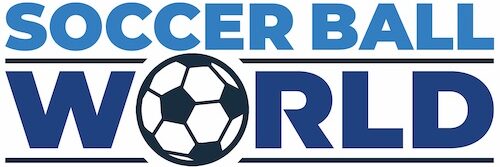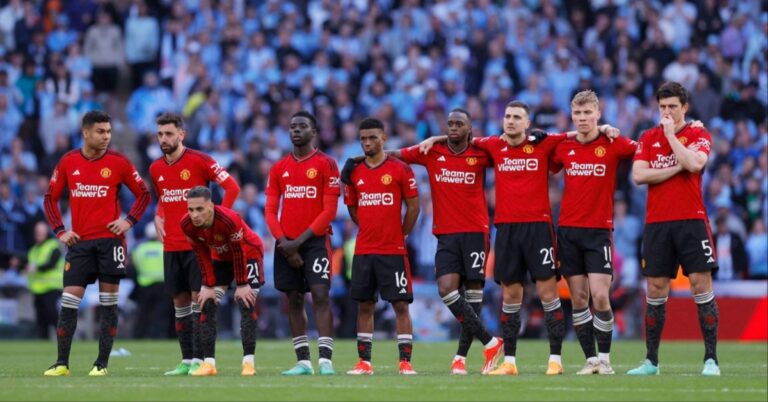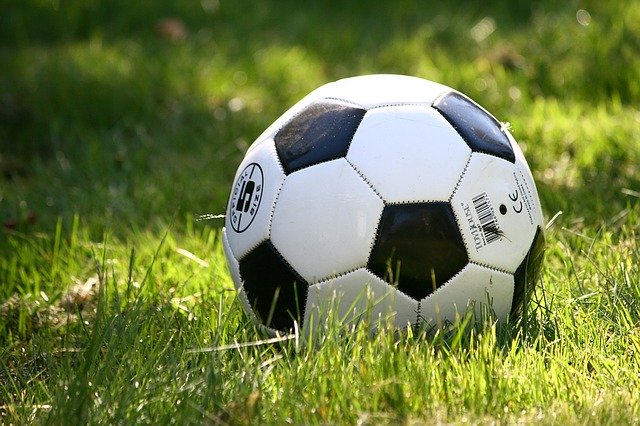Soccer Ball Dictionary

| A |
| AI-2000 -Type of high end synthetic leather material used to make the outer covers on soccer balls. For more information on soccer ball construction |
| B |
| BAR – The IS Metric unit of pressure equal to one million Dynes per square centimeter. One Bar is equal to 14.5038 pounds per square inch (PSI) . It is also nearly equivalent to one atmosphere of pressure. |
| Bladder – Used to retain the air in an inflatable ball. Usually made of latex or butyl. For more information click here. |
| Buckminster Soccer Ball or BuckyBall – The American architect Richard Buckminster Fuller came up with the design when he was trying to find a way for constructing buildings using a minimum of materials.The shape is a series of hexagons, pentagons and triangles, which can be fitted together to make a round surface. The modern football is essentially a Buckminster Ball consisting of 20 hexagonal and 12 pentagonal surfaces. When they are sewn together and inflated they make a near perfect sphere. For more information on the history of the soccer ball |
| Butyl Bladders – Type of material used in the construction of ball bladders. Retains air longer than bladders made from latex. |
| C |
| Carbon Latex Bladders – Type of material used in the construction of ball bladders. Retains air longer than bladders made from latex. Carbon is added to the latex to plug some of the microscopic holes that are in pure latex bladders. |
| Circumference – Measurement of the outer dimension of the soccer ball. Type of testing used in approving a soccer ball for FIFA match use. Assures that the ball will is with in the minimum and maximum specifications of circumference. For more information on FIFA soccer ball testing specifications |
| Cover – The surface of soccer balls or coverings are made up from synthetic leather and not full grain leather because leather has a tendency to absorb water causing the ball to become very heavy. Synthetic leather is typically made from PU (polyurethane) and PVC (poly vinyl chloride). For more information on soccer ball construction |
| D |
| DART (Dynamic Acceleration Response and Touch) – casing system used in some Nike soccer balls |
| E |
| F |
| FIFA Approved – Since January 1, 1996 only those outdoor soccer balls (footballs) which have been tested and meet the demanding quality criteria, bearing either of the official markings ‘FIFA Approved’, ‘FIFA Inspected’ or ‘International Matchball Standard,’ are allowed to be used in FIFA (Fédération Internationale de Football Association www.fifa.com ) competition matches and competition matches under the auspices of the six continental Confederations. For more information on soccer ball approvals |
| FIFA -Fédération Internationale de Football Association at www.fifa.com |
| FIFA Inspected – Since January 1, 1996 only those outdoor soccer balls ( footballs) which have been tested and meet the demanding quality criteria, bearing either of the official markings ‘FIFA Approved’, ‘FIFA Inspected’ or ‘International Matchball Standard,’ are allowed to be used in FIFA (Fédération Internationale de Football Association www.fifa.com ) competition matches and competition matches under the auspices of the six continental Confederations. For more information on soccer ball approvals |
| Football – THE GAME or THE BALL otherwise known as a soccer ball or futbol. Not to be confused with American football. |
| Futbol – THE GAME or THE BALL otherwise known as a soccer ball or football. |
| G |
| H |
| I |
| Impranil® – Adidas’s Fevernova soccer ball uses a special foam layer with tiny gas filled balloons imbedded in a syntactic foam. The foam is based on an abrasion resistant polyurethane made by Bayer. For more information on the Fevernova ball and other soccer ball innovations, click here. |
| International Match Ball (IMS) – Since January 1, 1996 only those outdoor soccer balls ( footballs) which have been tested and meet the demanding quality criteria, bearing either of the official markings ‘FIFA Approved’, ‘FIFA Inspected’ or ‘International Matchball Standard,’ are allowed to be used in FIFA (Fédération Internationale de Football Association www.fifa.com ) competition matches and competition matches under the auspices of the six continental Confederations. For more information on soccer ball approval |
| J |
| K |
| Korean Ducksung -Type of high end synthetic leather material used to make the outer covers on soccer balls. |
| L |
| Latex Bladders – Type of material used in the construction of ball bladders. Retains air less longer than bladders made from butyl. However; latex bladders tend to have a better “feel” than balls with butyl bladders. |
| Leather – Early soccer balls (footballs) were made with leather outer covers. However; the balls would absorb water and become very heavy. Synthetic leather materials are used in today’s balls because they do not absorb as much water. For more information on the history of the soccer ball |
| Leatherite – Synthetic leather usually PVC (Polyvinyl Chloride) or PU (Poly Urethane). |
| Lining – Multiple layers of lining are placed between the cover and the bladder. These layers are composed of polyester or cotton bonded (laminated) together to give the ball strength, structure and bounce. Professional soccer balls usually have four or more layers of lining. Promotional or practice balls are often constructed with less layers of lining. The lining helps the ball retain it’s shape and bounce over the life of the ball. For more information on soccer ball construction |
| Loss of Pressure – Type of testing used in approving a soccer ball for FIFA match use. Assures that the ball will not loose a certain amount of pressure over time. |
| M |
| MSB – Machine Stitch Ball or Machine Stitch Technology |
| Microfiber – Type of synthetic leather developed to look and feel like leather. Uses micro strands of fiber to simulate the grain structure of leather. High end soccer balls use microfiber for the outer cover. |
| N |
| NFHS – National Federation of State High School Associations at www.nfhs.org |
| NFHS Approved – Since the 1999-2000 school year, soccer balls used in interscholastic competition in sports for which the National Federation of State High School Associations (NFHS) writes playing rules are required to have the NFHS authenticating mark. For more information on this authenticating mark |
| O |
| P |
| Panels – The different segments that make up the outside of the ball — varies for each soccer ball design. For more information on soccer ball construction |
| PERIMETER BALANCE TECHNOLOGY (PBT) – Puma’s bladder balance technology used on their new Shudoh ball with dimples. |
| Pig’s Bladders – Used to retain the air in very old inflatable balls. Today, typical bladders are made of latex or butyl. For more information on the history of the soccer ball |
| Porvair – Type of high end synthetic leather material used to make the outer covers on soccer balls. |
| PSI – A measurement of pressure in the American system. By way of comparison, the weight of the atmosphere (one atmosphere) is 14.7 pounds per square inch, at sea level. In the IS Metric system, pressure is measured in Bars. To covert PSI to Bars, take the PSI figure and multiply it by 0.0689476. |
| PU – Poly Urethane – Type of high end synthetic leather material used to make the outer covers on soccer balls |
| PUMA AIR LOCK’ (PAL) – Puma’s bladder air valve technology used on their new Shudoh ball with dimples. |
| PVC – Polyvinyl Chloride – Type synthetic leather material used to make the outer covers on soccer balls. Usually used on practice type soccer balls because it is less scuff resistant than balls made with PU synthetic leather material. |
| Q |
| R |
| Rebound – Type of testing used in approving a soccer ball for FIFA match use. Assures that the ball will bounce to the specified minimum and maximum height at a certain temperature and ball pressure. |
| S |
| Shape and Size Retention – Type of testing used in approving a soccer ball for the “FIFA Approved” mark. Assures that the ball will keep it’s shape, pressure and size after subjecting it to 2000 simulated kicks against a metal plate. A machine is used to simulate the kicks at the specified speed and distance. |
| Soccer Ball – THE BALL otherwise known as a football or futbol. It is the ball used in a soccer match (duh). |
| Sphericity – Measurement of how “round” the soccer ball is. Type of testing used in approving a soccer ball for FIFA match use. Assures that the ball will not deviate more than the specified percentage from the mean value. |
| Stitching – The highest quality balls are stitched with a polyester or similar thread. 5-ply twisted polyester cord is the material of choice in stitching together a soccer ball. Hand sewn balls have tighter and stronger seams. Kevlar® reinforced polyester stitching is also used on some balls. For more information on soccer ball construction |
| Syntactic – special foam layer with tiny gas filled balloons imbedded within. Used exclusively in Adidas’s Fevernova soccer ball. |
| Synthetic Leather – Simulated leather used in the outer cover of soccer balls. |
| T |
| Teijin Cordley – Type of high end synthetic leather material used to make the outer covers on soccer balls. |
| TPU – Thermo Poly Urethane – Type of synthetic leather material used to make the outer covers on soccer balls. |
| Types – Soccer balls are generally categorized into four types, Professional Match, Match, Practice and Promotional balls. For more information click here |
| U |
| V |
| W |
| Water Absorption – Type of testing used in approving a soccer ball for FIFA match use. Assures that the ball does not absorb over the specified amount of water weight. |
| Weight – Measurement of how much a soccer ball weighs. Type of testing used in approving a soccer ball for FIFA match use. Assures that the ball weight is with in the specified range. |
| X |
| Y |
| Z |






